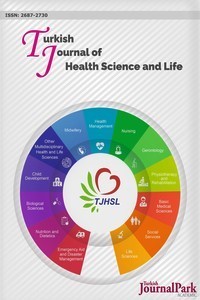Sociocultural Determinants in Adolescent Pregnancies: Evaluation of Contraception, Breastfeeding and Birth Outcomes
Sociocultural Determinants in Adolescent Pregnancies: Evaluation of Contraception, Breastfeeding and Birth Outcomes
Adolescent breast feeding, contraception, pregnancy.,
___
- Kuruvilla S, Bustreo F, Kuo T, Mishra CK, Taylor K, Fogstad H, et al. The Global strategy for women’s, children’s and adolescents’ health (2016-2030): A roadmap based on evidence and country experience. Bull World Health Organ. 2016;94(5).
- Naçar M GO. Adolesan sağlığı. . In: Öztürk Y GO, editor. Halk Sağlığı Genel Bilgiler . 2011. p. 711–46.
- Büyükgediz A. Adolesanlarda fiziksel ve cinsel gelişim. In: IUlusal Adolesan Sağlığı Kongresi Konuşma Metinleri Özet Kitabı. 2006. p. 35–9.
- Martin JA, Hamilton BE, Osterman MJK, Driscoll AK, Mathews TJ. Births: Final data for 2015. National Vital Statistics Reports. 2017;66(1).
- Bulut S GASÜ. Adölesan gebelikler. . Aile ve Toplum Dergisi . 2008;13:37–44.
- Taner CE, Aydoǧan Kirmizi D, Iriş A, Başoǧul Ö. Adölesan gebeliklerin sonuçlari{dotless}. Goztepe Tip Dergisi. 2012;27(1).
- Klein JD. Adolescent Pregnancy: Current Trends and Issues. Pediatrics. 2005 Jul 1;116(1):281–6.
- Guimarães AMDN, Bettiol H, Souza L de, Gurgel RQ, Almeida MLD, Ribeiro ERDO, et al. Is adolescent pregnancy a risk factor for low birth weight? Rev Saude Publica. 2013 Feb;47(1):11–9.
- Martínez HT, Silva MAI, Cabrera IP, Mendoza AJ. Obstetric profile of pregnant adolescents in a public hospital: risk at beginning of labor, at delivery, postpartum, and in puerperium. Rev Lat Am Enfermagem. 2015 Oct;23(5):829–36.
- Yılmaz E YZYIÖKMGİSB. Bir Eğitim ve Araştırma Hastanesinde Doğum Yapan Adölesan Gebelerin Obstetrik ve Perinatal Sonuçları. . Jinekoloji-Obstetrik ve Neonatoloji Tıp Dergisi . 2015;12(6):213–6.
- McCarthy FP, O’Brien U, Kenny LC. The management of teenage pregnancy. Vol. 349, BMJ (Online). 2014.
- Keskinoglu P, Bilgic N, Picakciefe M, Giray H, Karakus N, Gunay T. Perinatal Outcomes and Risk Factors of Turkish Adolescent Mothers. J Pediatr Adolesc Gynecol. 2007;20(1).
- Ekwo EE, Moawad A. Maternal age and preterm births in a black population. Paediatr Perinat Epidemiol. 2000;14(2).
- Gençcan ÖÜ. 4721 Sayılı Türk Medeni Kanununa göre evlenmeye izin davaları. Yayın Adalet Dergisi. 2005;74–83.
- Fraser AM, Brockert JE, Ward RH. Association of Young Maternal Age with Adverse Reproductive Outcomes. New England Journal of Medicine. 1995 Apr 27;332(17):1113–8.
- Smith GCS, Pell JP. Teenage pregnancy and risk of adverse perinatal outcomes associated with first and second births: population based retrospective cohort study. BMJ. 2001 Sep 1;323(7311):476–476.
- Bozkaya H, Mocan H, Usluca H, Beser E, Gümüstekin D. A Retrospective Analysis of Adolescent Pregnancies. Gynecol Obstet Invest. 1996;42(3):146–50.
- Ganchimeg T, Mori R, Ota E, Koyanagi A, Gilmour S, Shibuya K, et al. Maternal and perinatal outcomes among nulliparous adolescents in low- and middle-income countries: a multi-country study. BJOG. 2013 Dec;120(13):1622–30.
- Debras E, Revaux A, Bricou A, Laas E, Tigaizin A, Benbara A, et al. Devenir obstétrical et néonatal des grossesses chez les adolescentes : cohorte de patientes en Seine-Saint-Denis. Gynecol Obstet Fertil. 2014 Sep;42(9):579–84.
- Eftekhar K. World Health Organization. Appropriate technology for birth. Vol. 319, Lancet. 1999.
- Sağlıkta Performans ve Kalite Yönergesi (2011). https://shgmkalitedb.saglik.gov.tr/TR,6581/saglikta-performans-ve-kalite-yonergesi-2011.html. 2011.
- Chaura T, Mategula D, Gadama LA. Adolescent pregnancy outcomes at Queen Elizabeth Central Hospital, Malawi: a cross-sectional study. Malawi Medical Journal. 2021 Dec 22;33(4):261–8.
- Brown A, Raynor P, Lee M. Young mothers who choose to breast feed: the importance of being part of a supportive breast-feeding community. Midwifery. 2011 Feb;27(1):53–9.
- Sipsma HL, Magriples U, Divney A, Gordon D, Gabzdyl E, Kershaw T. Breastfeeding Behavior Among Adolescents: Initiation, Duration, and Exclusivity. Journal of Adolescent Health. 2013 Sep;53(3):394–400.
- Martin J a, Hamilton BE, D P, Sutton PD, Ventura SJ, Menacker F, et al. Births: Final Data for 2006. National Vital Statistics Repots. 2009;57(7).
- Dennis CL, Heaman M, Mossman M. Psychometric Testing of the Breastfeeding Self-Efficacy Scale-Short Form Among Adolescents. Journal of Adolescent Health. 2011 Sep;49(3):265–71.
- Glass TL, Tucker K, Stewart R, Baker TE, Kauffman RP. Infant Feeding and Contraceptive Practices Among Adolescents with a High Teen Pregnancy Rate: A 3-Year Retrospective Study. J Womens Health. 2010 Sep;19(9):1659–63.
- Tucker CM, Wilson EK, Samandari G. Infant feeding experiences among teen mothers in North Carolina: Findings from a mixed-methods study. Int Breastfeed J. 2011;6(1):14.
- de Oliveira LD, Giugliani ERJ, Santo LC do E, Nunes LM. Counselling sessions increased duration of exclusive breastfeeding: a randomized clinical trial with adolescent mothers and grandmothers. Nutr J. 2014 Dec 17;13(1):73.
- Dykes F, Moran VH, Burt S, Edwards J. Adolescent Mothers and Breastfeeding: Experiences and Support Needs—An Exploratory Study. Journal of Human Lactation. 2003 Nov 1;19(4):391–401.
- Wambach KA, Cohen SM. Breastfeeding Experiences of Urban Adolescent Mothers. J Pediatr Nurs. 2009 Aug;24(4):244–54.
- Woods NK, Chesser AK, Wipperman J. Describing Adolescent Breastfeeding Environments Through Focus Groups in an Urban Community. J Prim Care Community Health. 2013 Oct 12;4(4):307–10.
- McAndrew F, Thompson J, Fellows L, Large A, Speed M, Renfrew MJ, et al. Infant Feeding Survey 2010. The Health and Social Care Information Centre. 2012;
- Santo LCDE, de Oliveira LD, Giugliani ERJ. Factors associated with low incidence of exclusive breastfeeding for the first 6 months. Birth. 2007;34(3).
- French RS, Cowan FM. Contraception for adolescents. Best Pract Res Clin Obstet Gynaecol. 2009 Apr;23(2):233–47.
- ISSN: 2687-2730
- Başlangıç: 2018
- Yayıncı: Mümin POLAT
The effects of Bacillus amyloliquefaciens on Mentha piperita grown under salt stress
Songül Tuğba ÜNER, Aslıhan CESUR TURGUT
Streptococcus Spp. Isolated Subclinical Mastitis and Its Effect on Public Health
Ayşe Rabia ŞENKAYA, Sabahattin Anıl ARI, İbrahim KARACA
Aygül ÖZTÜRK, Akgün YEŞİLTEPE, Sinan ASLAN
Examining Covid-19 Related Anxiety and Obsession Levels Nursing Students
Endam ÇETİNKAYA, Hatice CEYLAN, Sevgi ASLAN BAYSAL
Mehmet KÖK, Fatma DURSUN ERGEZEN, Hilal Gamze HAKBİLEN, Emine KOL, Ayşe YACAN KÖK
THE NEURONAL ANTIINFLAMMATORY EFFECTS OF APELIN-13
Akif DOĞANTEKİN, Esin DOĞANTEKİN, Nevzat GÖZEL
Kemal Yetiş GÜLSOY, Semiha ORHAN
Evaluation of Dental Anxiety Levels of the Oral and Dental Health Program Students
